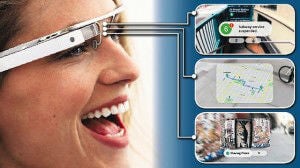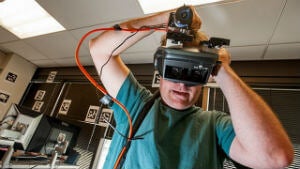2013 — The Dawn Of Wearable Computing?

Share
Sooner rather than later you'll have a computer attached to your face, and for some, it'll happen as early as next year. Why? Because the era of wearable computing is dawning as startups and established tech companies focus their efforts on designing eyewear that converges the digital and real worlds right before your eyes.
Whether you wear these headgear in the comfort of your living room or as you walk around in daily life, during your leisure time or at all times, or for work or play, the inescapable truth is that computers are taking the next logical step in their evolution from big chunky boxes to smaller wearable forms, which will open up new ways to be productive, social, and entertained. This window into connected life will take either of two forms: augmented reality, in which a digital interface is blended with the physical world, or virtual reality, where complete immersion in a synthetic world is achieved.
The key development in 2013 will be computers molded to human anatomy (finally!).
During the time that IBM introduced personal computers into the mainstream three decades ago, the concept of wearable computers emerged, primarily due to the 1983 film Brainstorm that featured a massive helmet device capable of capturing video and recording human sensations. Then in the 1990s, the functionality of PCs was expanded as they became even more connected through the Internet and the promise of greater mobility loomed with high-end notebooks (laptops) hitting the market.
But three things kept most computers firmly planted on desktops everywhere: the dependency on the electrical grid for power, the need for Ethernet cables to network, and a clunky form factor that has changed little since the first PCs.
Today, battery technology allows computers increasingly longer periods of time away from the grid. WiFi and other wireless technologies have effectively cut the Ethernet umbilicus allowing mobile computing to become widespread. But advances in electronics and miniaturization have yet to free computers from their recognizable rectangular forms. Even smartphones mimic the black brick forms of their monolithic-like predecessors.
It's time for computers to integrate with biology, and there's no better place to start than with the eyes.
That's exactly what Google has in mind. The April announcement for Project Glass last April was paradigm shifting in that it promised a connected anytime, anywhere minimalistic device that seemed to integrate easily into life and yet wasn't a smartphone. The Glass conceptual video that was released showed how functionalities of smartphones and web browsers could potentially be merged into an augmented reality user experience that was nonintrusive, fluid, and powerful. With this video, Google demonstrated its post-PC vision is one in which a computer serves as your wingman, allowing you to take center stage but ready to assist.
Since the initial unveiling, Glass prototypes have been donned by Google co-founders Sergei Brin and Larry Page, Google employees, and even models at a fashion show. Brin told Bloomberg that developer versions of the device called Explorer Editions would be out in early 2013 and "within a year after that I want to have broad consumer offering." Now it could be that Google Glass won't hit shelves until 2014, but you can guarantee that every sighting and news tip about the headset will be all over the media next year as developers talk about their experiences and what they hope to host on the device.
But Google doesn't have a corner on augmented reality. In fact, a number of Glass-like eyewear projects have shown up -- some on crowdfunding sites and others from talented DIY enthusiasts -- having more limited functionality, at least in the prototype stage. For instance, the startup Vergence Labs turned to crowdfunding sites Kickstarter, and later Indiegogo, to develop its social video sharing sunglasses, which allow a user to take photos or stream from first-person point of view. The project was successfully funded, overcoming a negative association with the bandit-like ZionEyez project (that raised $344,000 on Kickstarter in July of 2011 then disappeared). A few months back, a UK developer hacked the commercially available Vuzix video eyewear (letting you watch movies on sunglasses) to make a real-time language translator that shows translations of a foreign language as captions to the viewer.
Whether any of these specific projects become legitimate contenders to Google's Android-based device remains to be seen, but there's no doubt that many parties are looking at these glasses as the form factor that just might replace the mobile phone.
Be Part of the Future
Sign up to receive top stories about groundbreaking technologies and visionary thinkers from SingularityHub.


While these eyewear prototypes focus on augmenting vision with computers, others are looking at bringing full displays right before your eyes to deliver virtual reality goggles. This summer, a startup named Oculus ran an incredibly successful Kickstarter campaign for its Rift goggles. Bringing in nearly 10 times the requested funds and acquiring 9,522 backers, the total amount raised totaled $2.4 million. But unlike other crowdfunding campaigns aimed at getting gadgets directly to customers (like the Ouya console), the Rift project was aimed at getting prototype kits into the hands of developers and attracting them by garnering the support of some game industry heavyweights. In the end, nearly 75 percent of backers were slated to receive the dev kits, which means that integration into games and other software can be offered when the consumer version of the goggles go live.
Here was the Kickstarter pitch for the Rift goggles:
In an interesting development, Valve developer Michael Abrash and its president, Gabe Newell, throw in their support for the Rift goggles in the video. Last spring, only a few weeks after the announcement from Google Glass was released, Abrash put up a blog post stating that Valve itself would be venturing into hardware for augmented/virtual reality. In fact, Abrash called this project "wearable computing," coining the phrase, and leading the game developer on yet another one of its recent nontraditional directions. Abrash recently told The New York Times that "credible augmented-reality games could be three to five years away" after virtual reality glasses hit the scene. Though Valve may not ultimately manufacture any headgear in the end, the game developer has expressed a commitment to share what it learns openly with companies interested in developing devices, according to the article.
The initial focus on gaming makes sense for virtual reality hardware. After all, gamers are eager for technology that creates better immersion, whether it's needed for fast reaction time or deep connection to characters in a story. Virtual reality goggles may get honed in the gaming space, but the technology will expand into other areas as developers better understand how it can be utilized, just as Second Life has demonstrated how virtual worlds can be about more than just games. Ultimately, a headset that could allow the transition from regular eyewear into augmented reality and finally into full blown virtual worlds would provide the kind of all-in-one device that has made smartphones popular.
Next year is shaping up to be all about headsets, but developers are looking into other ways to make computers wearable. A recently issued patent uncovered Google's efforts to create a computer that would be a Minority Report-like Smart Glove. Another big player, Microsoft, is exploring a "wearable multitouch projector", a device (possibly glasses or something else) that projects the screen outward, turning any surface into a touch interface. These developments are taking place even as organic LEDs, long considered to be ideal for embedding displays into clothing, become cheaper.
With so many developers, entrepreneurs, and hackers pushing into wearable computing, our relationship with technology is poised to change and change quickly. Once computers migrate from being next to us to being worn on us, how long before they become a part of us?
Regardless of the augmented/virtual-reality hardware and software that ultimately rises to become the next standard by which all other devices are measured, wearable computers are destined to carve out for themselves some part of your field of vision. Let's face it -- we're being assimilated into a cybernetic relationship with computer technology, and though we may hold out, ultimately resistance is futile.
David started writing for Singularity Hub in 2011 and served as editor-in-chief of the site from 2014 to 2017 and SU vice president of faculty, content, and curriculum from 2017 to 2019. His interests cover digital education, publishing, and media, but he'll always be a chemist at heart.
Related Articles

This Light-Powered AI Chip Is 100x Faster Than a Top Nvidia GPU

How Scientists Are Growing Computers From Human Brain Cells—and Why They Want to Keep Doing It

These Brain Implants Are Smaller Than Cells and Can Be Injected Into Veins
What we’re reading



